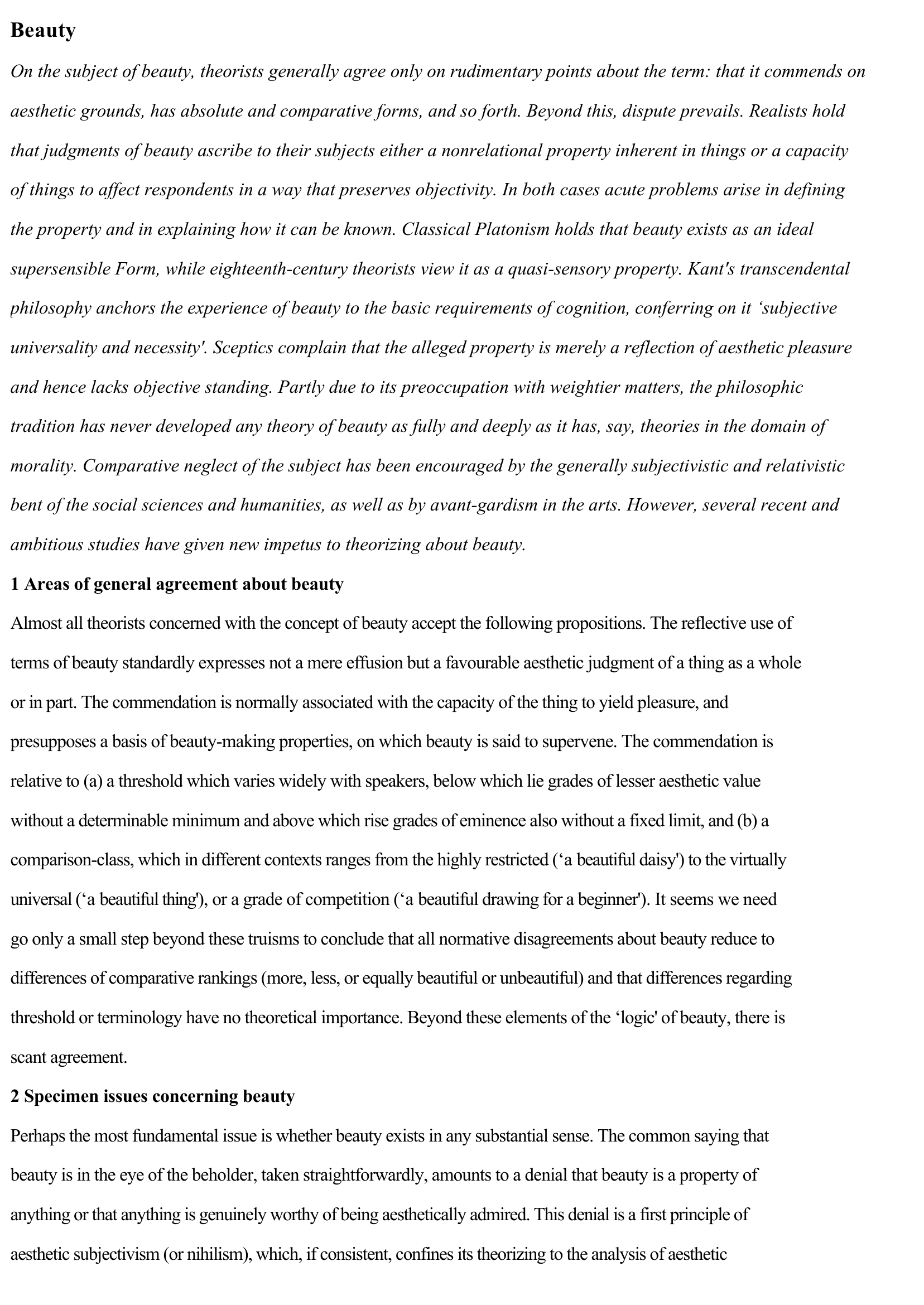Beauty
Publié le 16/05/2020
Extrait du document
«
Beauty
On the subject of beauty, theorists generally agree only on rudimentary points about the term: that it commends on
aesthetic grounds, has absolute and comparative forms, and so forth.
Beyond this, dispute prevails.
Realists hold
that judgments of beauty ascribe to their subjects either a nonrelational property inherent in things or a capacity
of things to affect respondents in a way that preserves objectivity.
In both cases acute problems arise in defining
the property and in explaining how it can be known.
Classical Platonism holds that beauty exists as an ideal
supersensible Form, while eighteenth-century theorists view it as a quasi-sensory property.
Kant's transcendental
philosophy anchors the experience of beauty to the basic requirements of cognition, conferring on it ‘subjective
universality and necessity' .
Sceptics complain that the alleged property is merely a reflection of aesthetic pleasure
and hence lacks objective standing.
Partly due to its preoccupation with weightier matters, the philosophic
tradition has never developed any theory of beauty as fully and deeply as it has, say, theories in the domain of
morality.
Comparative neglect of the subject has been encouraged by the generally subjectivistic and relativistic
bent of the social sciences and humanities, as well as by avant-gardism in the arts.
However, several recent and
ambitious studies have given new impetus to theorizing about beauty.
1 Areas of general agreement about beauty
Almost all theorists concerned with the concept of beauty accept the following propositions.
The reflective use of
terms of beauty standardly expresses not a mere effusion but a favourable aesthetic judgment of a thing as a whole
or in part.
The commendation is normally associated with the capacity of the thing to yield pleasure, and
presupposes a basis of beauty-making properties, on which beauty is said to supervene.
The commendation is
relative to (a) a threshold which varies widely with speakers, below which lie grades of lesser aesthetic value
without a determinable minimum and above which rise grades of eminence also without a fixed limit, and (b) a
comparison-class, which in different contexts ranges from the highly restricted ( ‘a beautiful daisy' ) to the virtually
universal ( ‘a beautiful thing' ), or a grade of competition ( ‘a beautiful drawing for a beginner' ).
It seems we need
go only a small step beyond these truisms to conclude that all normative disagreements about beauty reduce to
differences of comparative rankings (more, less, or equally beautiful or unbeautiful) and that differences regarding
threshold or terminology have no theoretical importance.
Beyond these elements of the ‘logic' of beauty, there is
scant agreement.
2 Specimen issues concerning beauty
Perhaps the most fundamental issue is whether beauty exists in any substantial sense.
The common saying that
beauty is in the eye of the beholder, taken straightforwardly, amounts to a denial that beauty is a property of
anything or that anything is genuinely worthy of being aesthetically admired.
This denial is a first principle of
aesthetic subjectivism (or nihilism), which, if consistent, confines its theorizing to the analysis of aesthetic.
»
↓↓↓ APERÇU DU DOCUMENT ↓↓↓

































